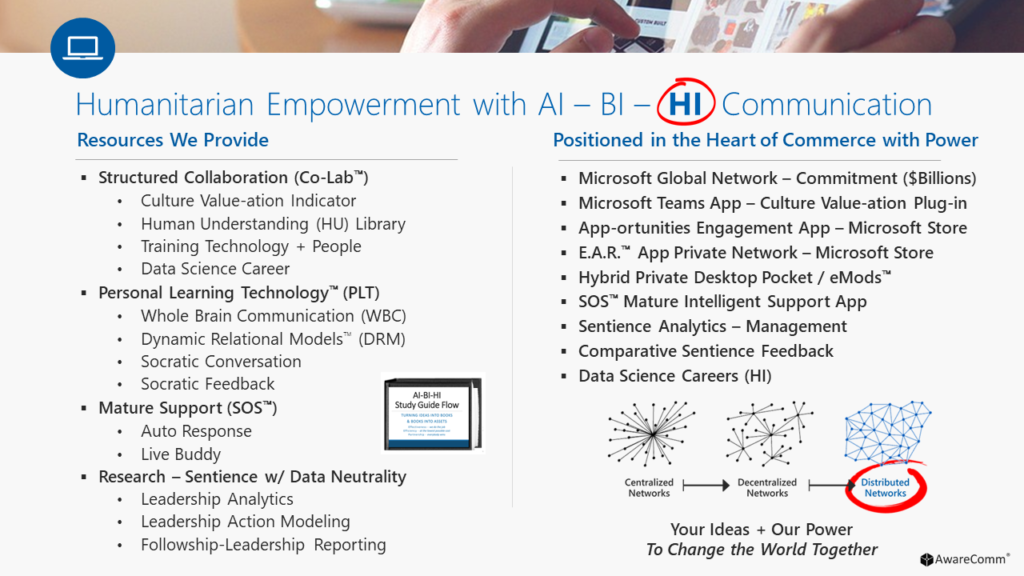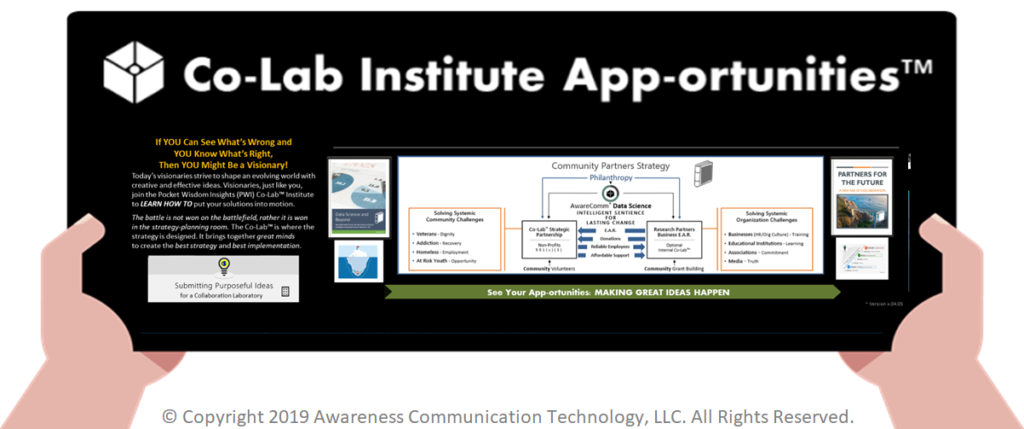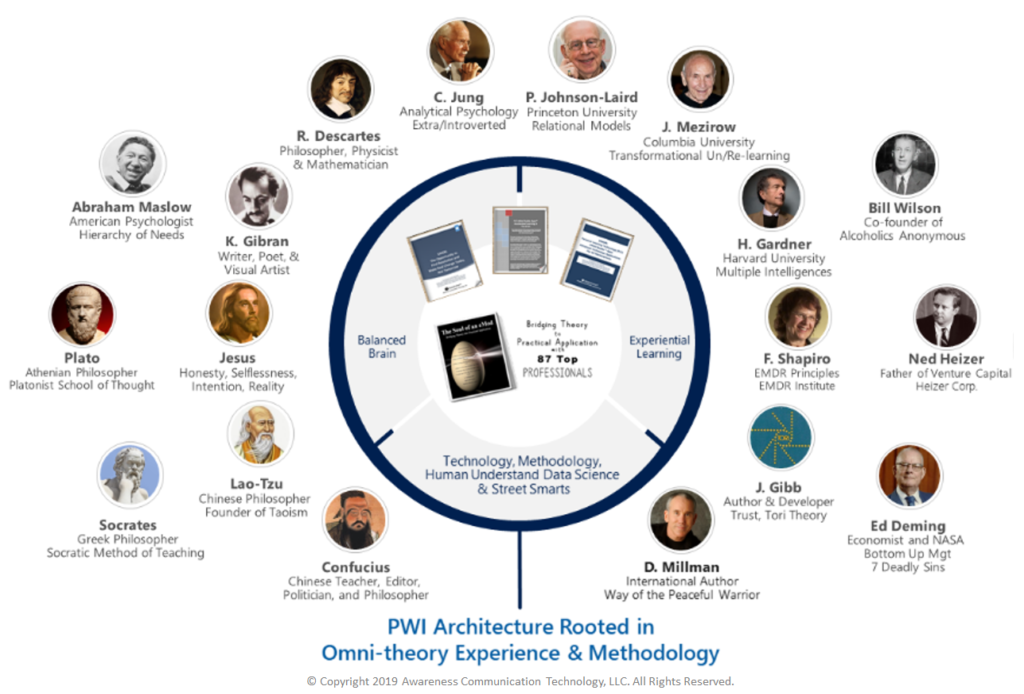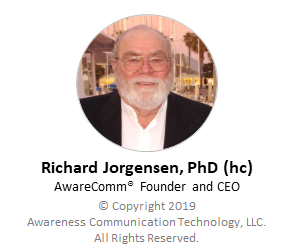
Offering a Social Change Perspective
Cyndi Suarez is back with the last of four articles describing the value of platforms, how to integrate them and the value they add to your operational strategy. This ongoing discussion is intended to illustrate the value and necessity of the AwareComm® platform to partnering organizations and communities.
As a multi-gold Microsoft research and development partner, AwareComm® offers a Platform as a Partnership (PaaP) that taps into the power of artificial intelligence (AI) blending with business intelligence (BI) to instill, nurture and expand human intelligence (HI). As you uncover the insight contained within this article, take a moment to consider what a proven, managed partnership platform that delivers AI+BI+HI could do for your organization vision.
Your Platform's Life Cycle
The following article was published by Nonprofit Quarterly "the leading journal of the nonprofit sector." It was written by Cyndi Suarez, "Senior Editor at NPQ."
This is the last of four parts in a management series for nonprofits on platforms as organizational forms. The series will describe the dynamics of how platforms work and how to approach balancing, growing, and sustaining them over time.
Metrics have a complicated place in nonprofit organizations, or in any efforts seeking social change. Trends have moved from measuring inputs, to measuring outputs, to measuring outcomes, to measuring impact.
Platforms amplify value and allow for clear measurement. They sidestep some of the challenges of measuring social change with their simple focus on curating high-quality interactions, which is also a key metric for a good society.
While a platform may be designed to track various indicators, the core metric is the number of satisfying user interactions. In other words, “Platform metrics need to measure the rate of interaction success and the factors that contribute to it.”1 With platforms, we learn to capture and measure network effects.
Metrics also correspond to the life cycle of the platform, or what phase of development it is in—from startup, to growth, to maturity. Platforms in the startup phase must track “the growth of their most important asset: active producers and consumers who are participating in a large volume of successful interactions.”2 Traditional metrics, such as revenues and cash flow, are not relevant in evaluating the strength of the platform in this phase.
In addition to the volume of successful interaction, platform managers should focus on the benefits that accrue to both producers and consumers. The purpose is to define success and failure, and identify how to improve the value of the platform for its users. There are three key metrics for this—liquidity, matching quality, and trust.
Platform liquidity is the state of minimum producers and consumers needed for a high percentage of successful interactions. “When liquidity is achieved, interaction failure is minimized, and the intent of users to interact is consistently satisfied within a reasonable period of time.”3 Though the formula, or the data collected to satisfy the metric, will vary from platform to platform, this is the first and most important milestone in the life cycle.
Matching quality is the accuracy of the process for seeking other users with whom to engage in successful interactions. “It is achieved through excellence in product or service curation.”4 This must be translated into a concrete quantity “with a clear operational definition.”5 One way to do this is to track users for a period of a few months to differentiate between different types and corresponding levels of activity. From this, the platform manager can determine a tipping point after which users become active. Then, the rate of users at this level can be tracked as a signal of platform strength.
The third key startup metric is trust, the degree to which users feel comfortable with the level of risk associated with interacting on the platform. As with matching quality, it is achieved through curation. “A well-run platform is one in which participants on both sides have been successfully curated so that users are comfortable with the level of risk involved in engaging.”6
Platforms that focus on content creation may require additional metrics. These include some measure for co-creation—“the percentage of listings that are consumed by users”— and consumer relevance—“the percentage of listings that receive some minimum level of positive response from potential consumers.”
In the growth phase, platform managers must ensure the vibrancy of the platform’s core interaction, and that the inflow of new users is greater than the outflow of users, so that the platform grows. This relies on a balance of users, or the producer-to-consumer ratio. Any efforts to balance focus on active users (“those who’ve engaged in interactions on the platform at a specific minimum rate of frequency that you consider appropriate”7). One way to do this is to measure the value of each user type.
Producer value can be measured by monitoring frequency of producer participation, listings created, outcomes achieved, and interaction failure—the percentage of interactions that are initiated but not completed. “These models capture the mechanisms by which repeat producers provide recurring platform [value] without incurring additional acquisition costs.”8 On the flipside, “because repeat producers are especially [valuable] to a platform, well-managed platform[s]…work hard to create active repeat producers.”9
Consumer value is tracked by monitoring frequency of consumption, searches, and rate of conversion—the percentage of searches that result in interactions. An additional metric is the side switching rate, or the rate of conversion from one user type to another, as in from consumer to producer.
In maturity, platforms focus on innovation, or the growth of improvement. One way to identify necessary innovation is to look at the adaptations that users are creating on the platform and determine which are used widely enough such that they should be incorporated into the core interaction somehow. In this way, the platform expands on its core interaction.
Notes
- Parker, Geoffrey G., Marshall W. Van Alstyne, Sangeet Paul Choudary. Platform Revolution. New York, London: W.W. Norton & Company, 2016. 186.
- Ibid, 187-188.
- Ibid, 190.
- Ibid, 191.
- Ibid.
- Ibid, 192.
- Ibid, 195.
- Ibid, 197.
- Ibid.
https://nonprofitquarterly.org/platform-life-cycle-and-metrics/
This article was originally published by NPQ online, on November 15, 2019 (https://nonprofitquarterly.org/platform-life-cycle-and-metrics/). Used with permission.
Implementing a Long-Term Platform Strategy
Imagine entering into a partnership built around an established platform that already addresses the important elements outlined in the article above. As an example, and as quoted above, "Platform metrics need to measure the rate of interaction success and the factors that contribute to it." The built-in AI+BI+HI of the AwareComm® PaaP includes a Culture Value-ation Indicator that not only collects data on what people are thinking, but it measure HOW they think and WHY they think the way they do. It then provides a confidential comparison of individuals to the collective group.
Beyond measuring the impact of the platform on all stakeholders, the AwareComm® PaaP includes all the tools needed to make long-term cultural, strategy and individual learning changes in your organization. When an operational element is knocked out of alignment with your organization vision you will have the proven power to gently return your eco-system to a state of collaborative effectiveness.

All Built into a Platform in a Box
Introducing App-ortunities, your gateway to the AwareComm® Collaboration Laboratory (Co-Lab™) platform. A deliverable, transferable and scalable eco-system of apps, methodology, technology, data science and human understanding with over 25 years of field implementation is available to approved partners possessing a social culturally responsible idea.

In order to build a community, you need a platform to build upon. Partner with the organization that's been building social culturally responsible platforms for the last 25 years.
Discover the Credentials
The AwareComm® founder and CEO, Richard Jorgensen, Ph.D. (hc) is a senior technology world veteran. He recalls, "I remember Bill Gates at his first Comdex (I believe it was) in Las Vegas when he appeared wide-eyed and bewildered with Windows 3.0. We all just smiled. Everybody must start somewhere. It turns out that he did okay, and today Microsoft’s legacy continues as Satya Nadella works to put the soul back into Microsoft."
The business and technology worlds of today struggle to grasp and apply:
- Data Science and Beyond
- True Learning vs Behavioral Conditioning
- Artificial Intelligence (transcend from not lose to…)
- Human Intelligence (creativity to win with a culture rooted in sentience)
- Organizing and Growing Communities that Seed and Support ALL Stakeholders
Dr. Jorgensen spent the last 30 years focused on those previous five points as they related to his life and career. As a result of his field research, a unique platform that offers a new dimension of Artificial Intelligence (Human Intelligence algorithm and human understanding Relational Models) was developed.
He has a legacy of quiet success and mentors to explain how he got here. Check out Dr. Jorgensen's LinkedIn Profile to learn more about the person and his social culturally responsible vision for humanity.
Dr. Jorgensen's Mentors, Advisors and Influencers
- Ned Heizer – Father of Venture Capital
- Earl Armstrong – Financial Consultant: Stanford Research Institute
- Jack Gibb – Renowned Author and Developer: Trust, Tori Theory
- Jim Mulvaney – Chairman of Board/CEO of Chela Financial Group
- Patty Burke – V.C. Fotomat, Speedy Print, Vitamin Manufacturing
- Dan Millman – Renowned Author, Publishing with HarperOne and Time Warner, Kramer Publishing
- W. Edwards Deming – Economist and NASA Bottom Up Management
- Edward Tufte, Ph.D. – Data Science / Analytics / Business Intelligence
Business Development History
- First IBM System 360 Team (ASP) Manufacturing Control Systems
- First DEC OEM Mini-Computer (PDP 8) National Beverage Distribution
- First AI Software Generator (J-Ware) Magazine Distribution and Analysis
- First Developer of Integrated AI SocraticQ™ Conversation/ Questioning
- First Financial Modeling System (Profit II) – Global Analytic Solutions
- First PLT Relational Behavioral Modeling Application (Princeton)
- First Symbolistics Application of Multiple Intelligences (Harvard)
Note from the AwareComm® Staff: Richard Jorgensen, Ph.D. (hc), earned doctorate as a result of his recognized contribution to humanity in the field of Social Research. The Humane Letters (hc) after his doctorate designation reference a level of devotion to humanity that is matched by very few. Dr. Jorgensen earned his doctorate from applying his research in the field successfully and to the benefit of those lives he touched.
Your Invitation
Fill out the eMod SocraticQ Conversation below to connect with the powerful AwareComm® Co-Lab™ team and discover how a partnership can strengthen your organization and establish a position of leadership in your target marketplace.


